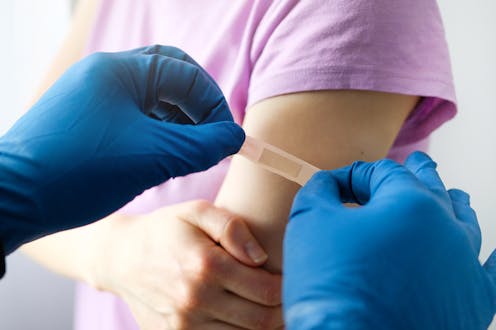NZ children face a ‘perfect storm’ of dangerous diseases as immunisation rates fall
- Written by Anna Howe, Research Fellow, University of Auckland

Routine childhood immunisations have dropped so dramatically globally during the COVID-19 pandemic that the World Health Organization and UNICEF[1] are raising the alarm.
Internationally, 25 million children[2] in 2021 alone have missed out on life-saving vaccinations. This is the largest sustained drop[3] in childhood immunisation in a generation.
In Aotearoa New Zealand, we are seeing a similarly concerning trend. The decline in childhood immunisation resulting in low overall coverage is now putting our tamariki (children) at real risk of preventable disease, especially with national borders open again.
The country is not alone in suffering collateral damage to normal childhood immunisation programmes due to the COVID-19 pandemic. But while the decline may be worrying, all is not lost.
Risk of disease outbreaks
Immunisation coverage at six months of age has fallen[4] in New Zealand from a high of around 80% in early 2020 to 67% by June 2022, and as low as 45% for Māori.
This is important because immunisation coverage at six months is used as a marker for timely receipt of lifesaving government-funded vaccines[5], including for whooping cough (pertussis), diphtheria, polio, pneumococcal disease and rotavirus.
For example, whooping cough[6] (pertussis), a particularly serious illness for babies, is a very real concern. Aotearoa has seen a pertussis resurgence[7] every three to four years, meaning we are due an increase in cases at a time when we also have low vaccine coverage.
Additionally, these declines in immunisation coverage and subsequent risk of infection are especially important to consider now, as international travel picks up.
References
- ^ UNICEF (www.unicef.org)
- ^ 25 million children (www.who.int)
- ^ largest sustained drop (www.who.int)
- ^ has fallen (www.health.govt.nz)
- ^ government-funded vaccines (www.health.govt.nz)
- ^ whooping cough (www.health.govt.nz)
- ^ pertussis resurgence (surv.esr.cri.nz)
- ^ CC BY-ND (creativecommons.org)
- ^ polio free (www.scielosp.org)
- ^ recent case (www.statnews.com)
- ^ Diphtheria is back in Australia, here's why – and how vaccines can prevent its spread (theconversation.com)
- ^ diphtheria (www.health.govt.nz)
- ^ borders fully open (covid19.govt.nz)
- ^ people were infected and 700 hospitalised (www.health.govt.nz)
- ^ particularly devastated (www.thelancet.com)
- ^ could have been prevented (www.health.govt.nz)
- ^ The most challenging phase of the Omicron outbreak is yet to come, but New Zealand may be better prepared than other countries (theconversation.com)
- ^ known immunity gap (journal.nzma.org.nz)
- ^ close this gap (www.health.govt.nz)
- ^ exception of 2020 (doi.org)
- ^ considered super-spreaders (www.influenza.org.nz)
- ^ already strained healthcare system (theconversation.com)

















